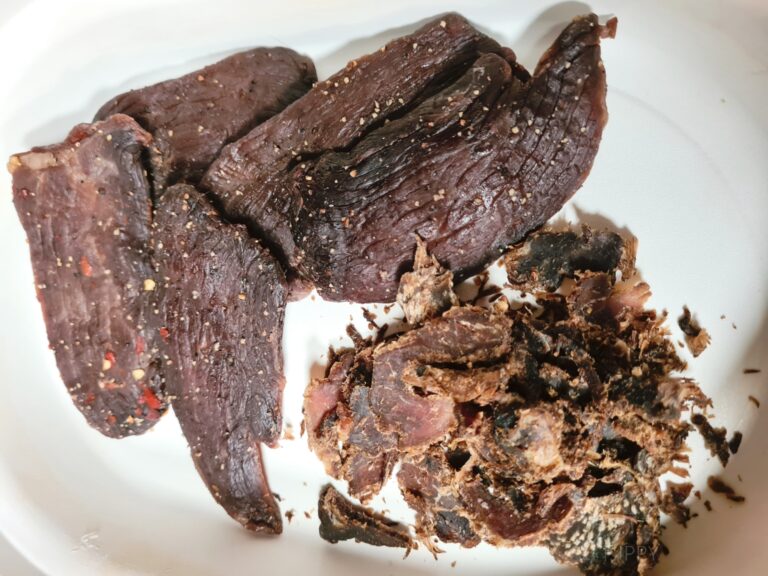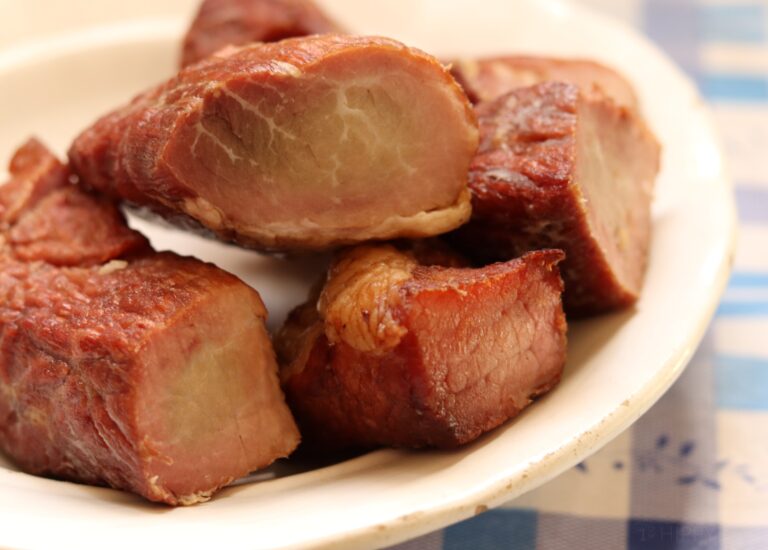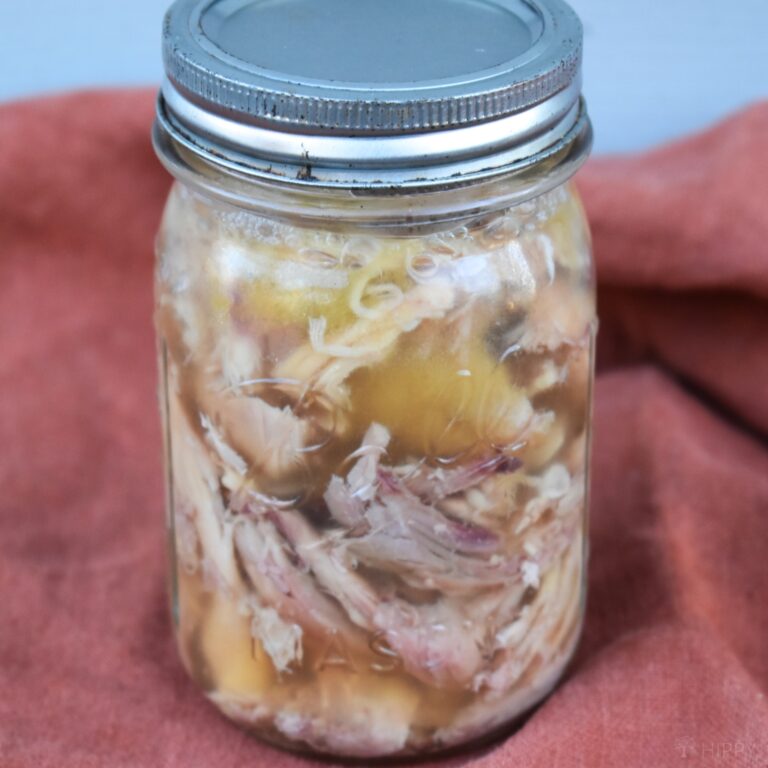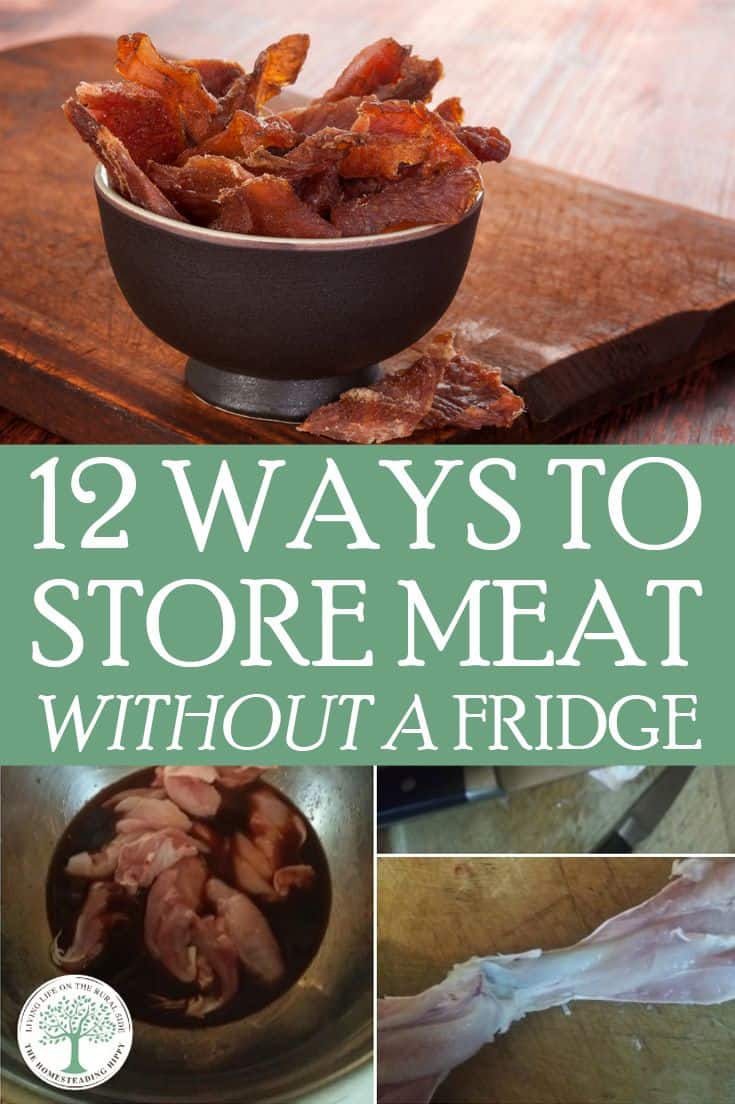Properly storing meat is crucial if you want to preserve it for later consumption. Most people nowadays have a refrigerator in their kitchens. Unfortunately, technology can, and does, fail occasionally.

If your fridge fails, it usually means you lose the contents; this can be a serious problem. With that in mind, how can you store meat without a refrigerator?
That’s what we’re going to look at today; here are 12 ways to store meat without refrigeration…
Table of Contents
What Are Some Food Preservation Options for Meat?
Whether you’re trying to preserve turkey or bacon, beef or chicken, here are some excellent methods to preserve meat for long-term storage – even if you don’t have a fridge!

1) Smoking
This is the oldest, traditional method of preserving meat. It was used primarily in areas that are too humid for air drying or dehydrating meat.
Something to note is that smoke contains carcinogens (toxins) that can cause serious problems health-wise. With that in mind, it’s recommended to consume smoked meat in moderation.
Smokers can be purchased or, if you’re good with your hands, you can build one yourself.
Cold smoking is another option for preserving meat.
Cold smoking is a process of preserving meat in which the food is exposed to smoke at a temperature below that at which the food would cook. This can be done by suspending the meat over smoldering wood chips or by using a dedicated cold smoker.
The goal of cold smoking is to impart flavor and texture to the meat without cooking it, so it is typically used for tougher cuts that would benefit from additional tenderizing.
Cold smoking also helps to repel insects, making it an ideal way to preserve meat for long-term storage.
In addition, the low temperature of cold smoking ensures that any bacteria present in the meat will not be able to grow and multiply, further extending its shelf life.
When properly executed, cold smoking can result in delicious, flavorful meat that will last for months.
2) Curing
Salting meat is another old method of preserving meat and it’s still used today; it takes a lot of time and patience to get it right. The process involves salting the meat.
Salt draws out all of the moisture in the meat which keeps the bugs off of it, and prevents it from spoiling immediately. It also helps inhibit the growth of bacteria and mold.
The process is similar to making biltong, the big difference being that you’d wait a bit longer and you’d hang the meat more or less in the open air. Talking about biltong leads nicely to our next method.
3) Dehydration
This is a very popular method in South Africa because dehydrating a steak gives us biltong (similar to beef jerky in the United States).
All you need is a dehydrator or biltong box (these can be purchased fairly easily online or at an appliance store). If you’d prefer, you also can build one yourself. A good light bulb and a fan will dry the meat out in anywhere from a few hours to a few days.
Dehydration removes the moisture from the meat without removing any nutritional value making it a great way to store meat without a fridge.
Something to note is that there are literally hundreds of videos on the topic of dehydrating meat. I selected one that I thought could be used for multiple types of meats in different forms (i.e. sliced, ground, etc.)
You can also check out our recipe for chicken jerky here.

4) Pressure Canning
Pressure canning uses pressurized steam to heat jars of meat and kill off the spores that carry the botulinum toxin. This is a very popular method for storing meat without a refrigerator because it’s incredibly easy to do.
It’s important to note that you can’t use a pressure cooker to do this; it has to be a pressure canner. It’s also only for low-acid foods (i.e. vegetables, meats, etc.).
Both raw packing strips of meat and hot packing (canning cooked meat in thin strips) are great options for home preservation. You can process canned meat with the bones in or out.
Check out our meat canning articles:
5) Brining
Brining involves soaking your meat in a solution of salt water (typically a mixture of water, salt, and sugar). The process results in a stronger flavor and a softer texture – making it easier to eat.
Generally speaking, you can brine any meat you want, but the leaner cuts will brine better. You also want to keep the meat submerged in the brine the whole time so weighing it down slightly so that it doesn’t float to the top of your container – out of the brine – is a must.
6) Confit
This method comes from France and involves cooking the meat while it’s submerged in its own fats. From there you let it cool and store it in the fat.
This preserves the flavor and keeps the texture nice and soft. You can add a variety of different spices to make things interesting depending on the cut of meat that you’re working with.
7) Storage in Lard
Okay, so admittedly; this is very similar to the previously mentioned Confit method. How? Well for starters, lard is rendered from the fatty tissue of a pig.
You layer the meat in the lard. This prevents any air from getting to the meat and prevents the meat from spoiling.
8) Freeze Drying
This is a less practical method as you’ll have to purchase a freeze dryer – which costs a pretty penny or two. The process involves freezing the meat and then lowering the pressure and removing the ice.
There is an extensive amount of preparation that goes into it but it’ll extend the shelf life of the meat. You can reconstitute it (make it soft again) by placing it in water for a bit.
9) Pickling
Pickling involves submerging your meat in an acidic solution (i.e. vinegar) with a PH 4.6 and leaving it to sit. You can pickle practically anything, but there are obviously limits and, if done incorrectly, you’ll lose your meat.
Personally, I don’t like pickles in general so pickled food just doesn’t appeal to me. It’s not that the food is bad, I think it’s more the smell of the vinegar solution or whatever it is that they put in pickle jars nowadays.
That said, the method works – provided you don’t try pickling things like bread (yuck) – and the logic behind it is sound. If it works, then why not use it?
10) Pemmican
Pemmican is an old Native American method of preserving meat and/or fish without refrigeration for an extended time period. It’s made from dried meat, rendered fat (tallow), and dried berries.
Berries are optional but they add to the flavor and texture of the pemmican. It’s important to note, and most videos on the subject of making pemmican will say this too, that you want the leanest possible meat.
The video demonstration above has the meat being dried and then blended into a fine powder which is then mixed with powdered, dried fruit and bound together using tallow.
I don’t know about you guys, but I don’t keep powdered anything in my fridge – which brings us back to fridges.
Every video I’ve seen has the mixture being refrigerated for a few hours… I don’t know if that makes this invalid (you can leave it to harden at room temperature as well) but it’s a cool idea.
11) Potted Meat
Potted meat is another old preservation method that involves using the fat of the meat. In this case, you cook the meat and then place it in a container and pack it tightly.
Once that’s done, you cover it in hot fat. The fat will harden as it cools and forms an airtight seal.
This is something that I’ve seen in supermarkets in South Africa a few times, but I’ve never tried it. Admittedly, that could be because most of the time it’s a paste to be spread on toast.
12) Natural Refrigeration
This is a largely impractical method for meat storage but it’s still an option – if you live in a colder climate. The basic setup is that you store the meat outside in the winter months; as long as you keep an eye on the thermometer.
Some people use wells to do this; keeping the meat in air/watertight jars and leaving the jars in their wells for short-term storage.
Now, this is impractical as you can’t really control the weather: it’ll change on a dime, which can damage your meat. There’s also the added risk of attracting predators like wolves or bears to your homestead with the scent of raw or frozen meat.
If they can score an easy meal, they’ll go for it and you could lose a lot of meat this way; depending on what predators are in your area and in what numbers.
FAQ
Poultry and seafood, for example, should be refrigerated as soon as possible to prevent bacterial growth. Pork and beef can last a little longer at room temperature, but they should still be cooked within two hours. Lamb and veal, on the other hand, can last up to four hours before they need to be cooked.
When it comes to extended storage, however, certain types of meat will last longer than others. Cured meats like ham and bacon can be stored in the fridge for up to two weeks, while fresh pork and beef will only last for three to five days.
When it comes to food safety, the general rule is that perishable foods should not be left out of the fridge for more than two hours. This is because warm temperatures provide the perfect environment for bacteria to thrive.
However, there are some exceptions to this rule. For example, cured meats such as ham and bacon can be stored at room temperature for up to a week.
Cold temperatures slow down the growth of bacteria, which is what causes food to spoil. Meat that is properly packaged and stored can also last longer than that that isn’t.
Vacuum-sealed bags and airtight containers help to keep oxygen out, which can cause meat to spoil more quickly.
In Closing
The idea of storing meat without a refrigerator is something that I’ve wondered about for the last few months. As the world changes around us, it’s getting to a point where we have to plan for unprecedented situations and think on the fly.
This article highlighted an interesting point in regard to the whole prepper lifestyle; we all grab what we think we’ll need and ignore what we actually need.
We build our little bunkers and storage facilities and then stock up on firearms, ammunition, knives, and so on but simple things like food and water are largely ignored.
The human body can last for a week or so without food when properly hydrated. It’s generally uncomfortable but it can be done.
On the other hand, we can only last 2 or 3 days without water before dehydration sets in. There have been cases where people have lasted longer but those are few and far between.
Now, I do have to be fair and say that this isn’t always the case. People have learned to stockpile food and water so that they’re better prepared for a bad situation.
As always, I hope you found this article informative and enjoyable. If you know of any other methods for storing meat without a refrigerator then please do let me know. Be sure to pin this on one of your Pinterest boards for later!


Greg spent most of his childhood in camping grounds and on hiking trails. While he lives in the suburbs nowadays, Greg was raised on a small farm with chickens. He’s a decent shot with a bow, and a huge knife enthusiast. Find out more about Greg.

If I dehydrate slices of chicken, and then fry them, does that defeat the purpose of dehydrating them in order to store without refrigeration?
In a survival situation where you have no time I was thinking a 10 day soup is one way to store a fresh kill. If you kill an animal that will take more than a week to eat then get the largest pot you can find and make soup. Then keep the soup at 190 degrees until you are able to eat all of it. If that is 3 days or maybe even 3 weeks.
Thoughts?
Hanging meat/poultry in open air. Dry it very very well. It’s excessive moisture that breeds bacteria and causes meat to sour. I learned this in a small, remote village in Mexico where there were meat/poultry venders hanging meat/poultry in the open air in warm weather but out of direct sunlight. The meat was dried very well and hung where it didn’t touch anything. It would last indefinitely as it formed a thin dry layer on the surface that protected it from bacteria and from souring. When we package and refrigerate our meats it create a very wet environment that promotes the growth of bacteria and souring as the meat sits in its own juices. We call that Salmonella Soup…yuk.